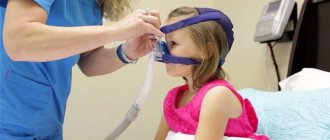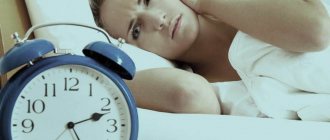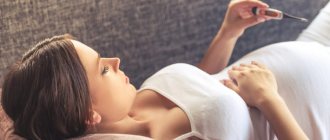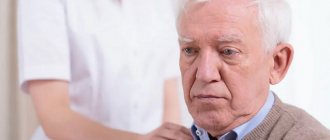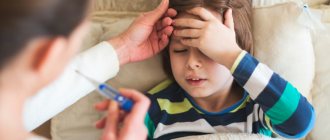Stopping breathing in a sleeping child, or sleep apnea, can be the result of a variety of reasons, ranging from the characteristics of age-related physiology to serious diseases caused by genetic mutations. Depending on the nature of the disorders, childhood apnea:
- not dangerous to the baby’s health, and therefore does not require any measures;
- threatens the child’s life and/or leads to mental retardation, frequent headaches during wakefulness, and the development of hyperreactivity syndrome;
- disappears on its own or after proper treatment, or... persists for life.
Below you will find more detailed information about the etiology of apnea in infants and young children, possible consequences and modern approaches to solving the problem.
Apnea in children under one year of age: why it occurs, dangerous or not dangerous
Due to insufficient morphological and functional development of the respiratory system of a child born prematurely, he often has respiratory arrests for 20 seconds or more (pauses can be shorter), accompanied by a slow heart rate (bradycardia) and a decrease in the level of oxygen in the blood.
Apnea in premature infants is one of the most common disorders that require the newborn to be in the intensive care unit under constant medical supervision. The earlier the child was born, the more often the episodes of apnea occur and the longer their duration.
The danger of apnea of prematurity is not only the risk of sudden death due to the fact that breathing does not resume, but also the insufficient supply of oxygen to the brain tissue. A set of special measures eliminates this problem.
Neonatologists cope with apnea of prematurity using CPAP machines and masks for infants working under special programs
As a rule, the respiratory system and the mechanisms for regulating its work in prematurely born newborns are fully formed and rebuilt by 37-40 weeks from the day of conception. That is, by the time the child would have been born if the mother had carried him to term. However, in very premature infants, apnea often occurs in a later period.
Episodes of sleep apnea in full-term infants under one year of age also occur and may be a normal variant. In the first year of life, short-term pauses in breathing during night sleep should not alarm parents if:
- their number does not exceed one episode per hour;
- the baby breathes effortlessly, deeply and evenly;
- apnea lasts no more than 5 seconds;
- the child does not show anxiety, his heartbeat does not slow down, and his skin does not appear blue.
However, if you notice that during sleep your baby stops breathing for some period of time, it is best and most correct to find the opportunity to undergo a special examination - polysomnography. Or, at a minimum, get an appointment with a specialized “sleep specialist” - a pediatric somnologist.
How does this happen
As a rule, sleep apnea in adults is associated with snoring: a person snores evenly for some time, then there is silence, lasting about 5-10 seconds, followed by a loud snore, and the sleeper begins to toss and turn restlessly. During a night's sleep, some patients have up to two hundred such stops. As a rule, a person with apnea is unaware of his condition or considers it normal.
However, regular breath holdings do not pass without a trace, because at this time the body does not receive the oxygen it needs. The brain suffers the most, but oxygen starvation also negatively affects the functioning of the heart.
Genetic pathologies are one of the causes of childhood sleep apnea
More frequent and prolonged episodes of sleep apnea in children under one year old born at term are usually associated with certain genetic abnormalities:
- CVCAHV (congenital central alveolar hypoventilation syndrome),
- SMA (spinal muscular atrophy),
- PWS (Prader-Willi syndrome), etc.
Genetic disorders that provoke apnea also occur in premature babies; in this case, it is very important to correctly determine the cause of respiratory arrest.
“Bad” genes can be inherited or appear spontaneously during fetal development for as yet unknown reasons.
Perhaps in the not too distant future, genetic engineering will give doctors the opportunity not only to promptly detect, but also to correct genetic abnormalities in the fetus during pregnancy or after the birth of a child. However, at present, the “wrong” set of genes cannot be “fixed.” And pathologies such as, for example, SVCAHV, which cannot be corrected with drugs, can cause the death of a child during sleep (the so-called Ondine syndrome), which requires special measures and supportive therapy throughout life.
Newborns with SVCAH usually undergo surgery, during which a hole is created in the trachea and a special tube is installed - a tracheostomy. During sleep (and in severe cases, during wakefulness), a ventilator is connected to it. After reaching the age of 6-7 years, the tracheostomy can be removed, and the child can be transferred to non-invasive mechanical pulmonary ventilation.
Tracheostomy in a girl with Ondine syndrome
However, recently, more and more neonatologists, including leading Russian specialists, are inclined to the possibility of initially using non-invasive methods of ventilation in children with mild forms of mutations. Fortunately, modern, compact, silently operating, intelligent devices, equipped with special masks that can be easily adapted to the facial structure of a particular baby, make it possible to solve this problem.
For example, a case of successful treatment in the Russian Federation of a twin girl with “Ondine syndrome” using non-invasive hardware methods from birth is described. The child was born in the Perinatal Center of the Clinic of the Institute of Perinatology and Pediatrics of the Federal State Budgetary Institution "National Medical Research Center named after. V. A. Almazov" premature, but experienced doctors under the guidance of Ph.D. Natalya Aleksandrovna Petrova, quickly determined that stopping breathing during sleep is not associated with the immaturity of the respiratory system, but with SVCAHV, which was confirmed by molecular genetic diagnostics.
Several years have passed since then, during which the child grew up, keeping up with his sister and peers in development. Currently, the main problem for Varya and her family is the need to monitor the operation of the device and the girl’s condition every night. According to Dr. Petrova, “...in our country, social support for these people is still insufficient. In many countries, patients with Ondine syndrome are assigned a night nurse who helps monitor breathing during sleep. In Russia...it is necessary to improve the awareness of the medical community about this disease, gain experience in ventilation at home and thereby ensure normal living conditions for the child...”
Thanks to the “smart” device and specialists from St. Petersburg, Varya did not need surgery
It should be added that hypoventilation of the central type may not be congenital, but appear at a later age (from 1.5 to 9 years), accompanied by obesity, hypothalamic and autonomic dysfunction (ROHHAD syndrome).
Apnea in children with genetic diseases is very dangerous, but with the right approach its consequences can be minimized and the child’s life can be made as comfortable as possible.
Fortunately, hereditary and other gene abnormalities that lead to sleep apnea in children are extremely rare. What cannot be said about such a common diagnosis as adenoids. Pathologically overgrown nasopharyngeal tonsils interfere with the passage of air through the respiratory tract of a sleeping child, as a result of which he snores, breathes convulsively and unevenly, with stops. These children are diagnosed with obstructive sleep apnea syndrome (OSA) and are treated by ENT doctors.
Prevention measures
To prevent snoring, it is recommended to promptly treat respiratory infections and allergic reactions.
As general measures it is recommended:
- Avoid a sedentary lifestyle and do daily exercise.
- Avoid using antihistamines before bed.
- Do not eat food before going to bed.
- Avoid excessive fatigue.
- Sleeping preferably on your side is better than sleeping on your back.
- Place the headrest by raising the headboard.
Obstructive apnea in children with adenoids: causes, danger, treatment approaches
Almost all children have adenoids, but if they are small in size (first degree), they practically do not interfere with the passage of air through the respiratory tract of a sleeping child, and OSA does not occur.
At the same time, obstructive apnea syndrome of varying severity develops in 50% of children with larger adenoids. In the second degree, at the time of the deep phase of sleep, hypertrophied tonsils cover more than half of the lumen of the airways; in the third or fourth degree, they block them completely.
During sleep, large adenoids can almost completely block the access of air to the airways
- Always remember that your snoring child with adenoids has a 50% risk of stopping breathing forever one night!
Therefore, children's snoring, especially uneven snoring, accompanied by wheezing inhalation, increased movements of the chest and its depression, periodic stops in breathing, is a reason to immediately contact a specialist for advice and a special examination.
Case from medical practice:
Moscow somnologists drew attention to a video filmed by the mother of 3-year-old Maxim M. from Kaliningrad. The woman was desperately looking for an opportunity to help her son - and she was absolutely right. As it turned out, the baby was literally between life and death. With one look at the sleeping child, specialists immediately determined a severe degree of obstructive sleep apnea, which was confirmed by polysomnography. The examination revealed 140 (!) episodes of respiratory arrests per hour. Since OSA was caused by adenoids that relapsed after traditional surgery, ENT doctors joined in the treatment: Professor Rusetsky Yu.Yu. and candidate of medical sciences Latysheva E.N. The boy underwent endoscopic removal of the adenoids, after which the problem completely disappeared.
| The chest is deformed, sinks when sighing, the mouth is open, the child snores heavily, breathes with difficulty, breathing stops on average every 2 minutes | The child does not snore, breathes evenly, constantly, calmly, through the nose, the chest is not deformed |
Sleeping Maxim before and after surgery
In general, when treating children with adenoids, ENT doctors adhere to the following rules:
- Grade 1 – no removal required.
- Grade 2 – examination is necessary to determine the presence of OSA and its severity.
- Grade 3-4 – surgery is indicated.
OSA can also develop in children with a pathological structure of the respiratory tract, for example, with a deviated nasal septum, cleft palate, hypertrophy (enlargement) of the root of the tongue, etc. In this case, as with severe adenoids, they resort to surgery.
In addition to polysomnography, SLIP endoscopy helps to decide on the choice of treatment tactics. During this study, the child is put into a light, close to natural, medicated sleep. After which, using a thin probe, his upper respiratory tract is examined to determine the presence of obstacles and determine their location.
Diagnostic methods
If parents suspect that their child snores, they should consult a doctor to confirm the diagnosis and assess the severity of the disorder:
- X-ray of the sinuses;
- layered image of the nasopharynx (CT);
- endoscopy (allows you to simultaneously take material for analysis);
- swab from the throat and nose for microflora;
- detailed blood test.
Overnight polysomnography is prescribed - this is the most informative scan. Video recording during sleep, if it is long (more than four hours), can be very useful in making the correct diagnosis.
Prevention measures
It is always easier to prevent a problem than to solve its consequences later; apnea in newborns is no exception. Recommended prevention is to comply with the following conditions. Quitting smoking during pregnancy. This is often the main factor in the occurrence of apnea. Until the age of 2, it is advisable for a child to sleep without a pillow and on a hard mattress.
Avoid situations where the baby sleeps on his stomach. Try to turn him on his back or side. The air temperature in the room where the baby sleeps should not rise above 22 °C; the room must be regularly ventilated. Stuffiness slows breathing, so don't wrap premature babies in a bunch of blankets.
Until the age of 2, the child sleeps in the room with his parents so that they regularly monitor his sleep and breathing. There are special devices that record the dynamics of a child’s breathing, and if it disappears during sleep, a sound will be heard. But such devices should be used only as prescribed by a doctor.
So, children prone to obstruction should be under the supervision of a doctor. And young parents in the event of an attack need to remain calm and clearly follow all prescribed actions. With age, this pathology goes away and breathing returns to normal.
Advantages of treatment at the RebenOK clinic
If parents notice a child snoring during sleep, it is recommended to consult a specialist in pediatrics or otolaryngology. The RebenOK clinic employs doctors with extensive practical experience and high qualifications. If snoring is diagnosed in a child during sleep, then effective conservative or surgical treatment is prescribed.
The medical center provides a doctor home call service. A specialist will conduct an initial examination in conditions familiar to the child and, if necessary, invite the patient to the clinic for a comprehensive diagnosis.
Inhale-exhale
Before starting to fight apnea, pediatricians recommend familiarizing yourself with the types of breathing in newborns. After all, even such a universal process occurs differently for each child and can be characterized by different dynamics, rhythm and tempo.
There are 4 types of breathing:
- regular – characterized by a stable supply of air with equal intervals between inhalations and exhalations;
- irregular – interrupted and instability of the respiratory system is observed, expressed in unequal time intervals;
- periodic – interruptions are typical, as well as a change from increased breathing to weakened breathing; such attacks occur alternately with an interval of up to 3 seconds;
- pronounced apnea is the most dangerous type of breathing, requiring constant monitoring, since there may be no air absorption for up to 10–15 seconds.
No ads 1
Blockage of the airway causes the baby's fourth type of breathing. And the signal from the central nervous system to the respiratory tract may also stop. In addition to the lack of breathing, this phenomenon is characterized by bradycardia, when the myocardium contracts to 60 beats per minute.
This diagnosis is scary because prolonged cessation of breathing can lead to death. And parents can only find out about what happened the next morning, because in most cases there are no characteristic sounds. But there are also cases when you can hear disruptions in the child’s breathing, and if this has already happened before, from now on you need to be very careful and try to spend more time at the crib.
Symptoms of sleep apnea
Patients usually do not realize that they have this disease. They only learn about the problem from those sleeping nearby.
Main symptoms in adults:
- Snore.
- Depression.
- Intermittent sleep.
- Decreased sexual activity (possible development of impotence).
- High physical activity.
Inadequate sleep contributes to the development of neurophysiological disorders:
- Morning headaches;
- Feeling unwell;
- Excessive sleepiness during the day;
- Reduced performance;
- Increased sensitivity;
- Memory impairment;
- Fatigue;
- Decreased concentration.
Gradually, weight is gained and problems with the reproductive system develop.
Apnea has a negative effect on the heart, causing arrhythmia, failure, and angina. Every second patient has concomitant problems that significantly complicate the course of the disease.
Signs of apnea in young patients are mouth breathing, urinary incontinence, sweating, lethargy.
